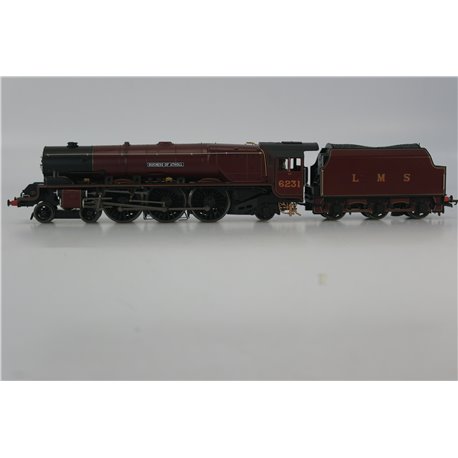No products
Product successfully added to your shopping cart
There are 0 items in your cart. There is 1 item in your cart.
Hornby R3553 Class 8P Princess Coronation 4-6-2 6231 "Duchess of Atholl" in LMS Crimson Lake. Used. OO Gauge
UP-T7536
This product is out of stock
| Scale | OO (1/76) |
More info
Hornby R3553 Class 8P Princess Coronation 4-6-2 6231 "Duchess of Atholl" in LMS Crimson Lake. DCC Ready
The London Midland and Scottish Railway (LMS) Coronation Class is a class of express passenger steam locomotives designed by William Stanier. They were an enlarged and improved version of his previous design, the LMS Princess Royal Class, and on test were the most powerful steam locomotives ever used in Britain at 2,511 dbhp. The locomotives were specifically designed for power as it was intended to use them on express services between London Euston and Glasgow Central; their duties were to include the hauling of a proposed non-stop express, subsequently named the Coronation Scot. The first ten locomotives of the Coronation class were built in a streamlined form in 1937 by the addition of a steel streamlined casing. Five of these ten were specifically set aside to pull the Coronation Scot. Although a later batch of five unstreamlined locomotives was produced in 1938, most of the ensuing Coronation class were outshopped as streamliners. Eventually, from 1944 until production ended in 1948, all-new engines would be built in unstreamlined form and all the streamliners would have their casings removed. The very last of the 38 locomotives was completed in 1948. After a successful decade of operations in the 1950s, the 1960s' modernisation plan was the ultimate undoing of the Coronations. Not only did the increasing use of diesel locomotives make many of the class redundant, but the electrification of the main line between London Euston and Crewe also resulted in their banishment from this important section of the main line as there was insufficient clearance between the locomotives and the live wires. With no useful role to play, the survivors were scrapped en masse from late 1962 to late 1964. Fortunately, three locomotives were saved for preservation.
This engine is in "As New" condition and had not been run prior to us taking it out of its box to test. Everything is exactly as you would expect from a new engine, including the box, accessories and paperwork.







